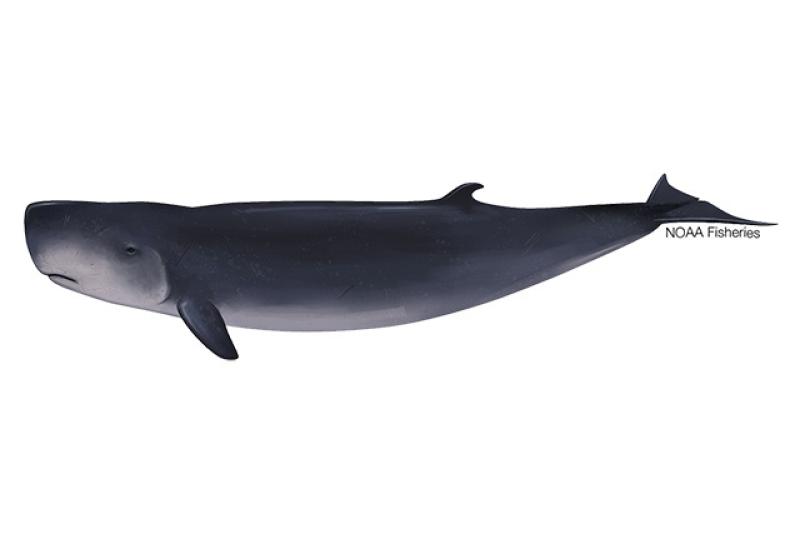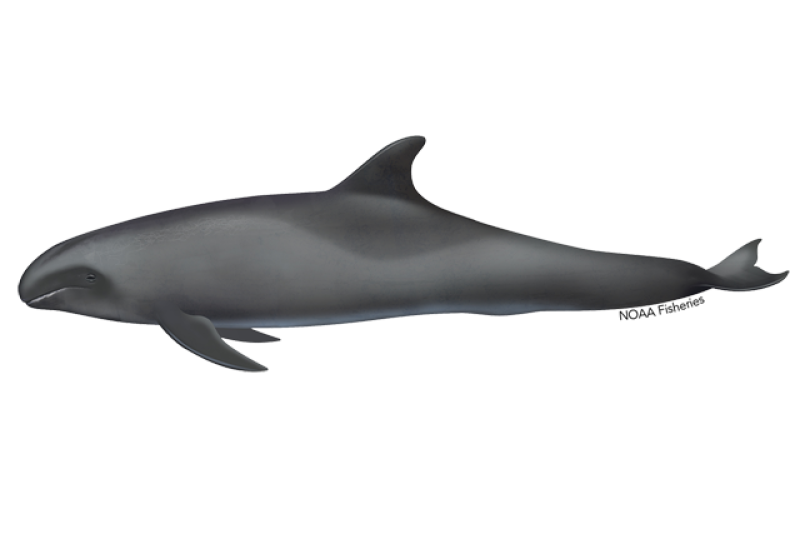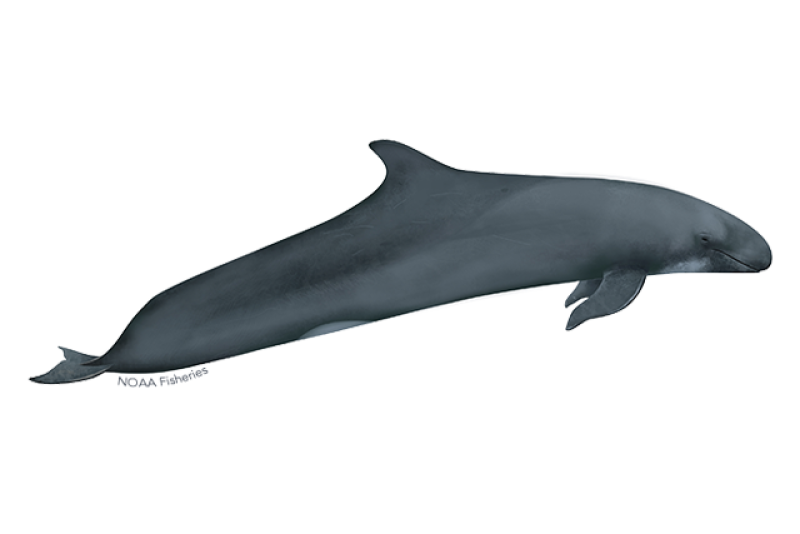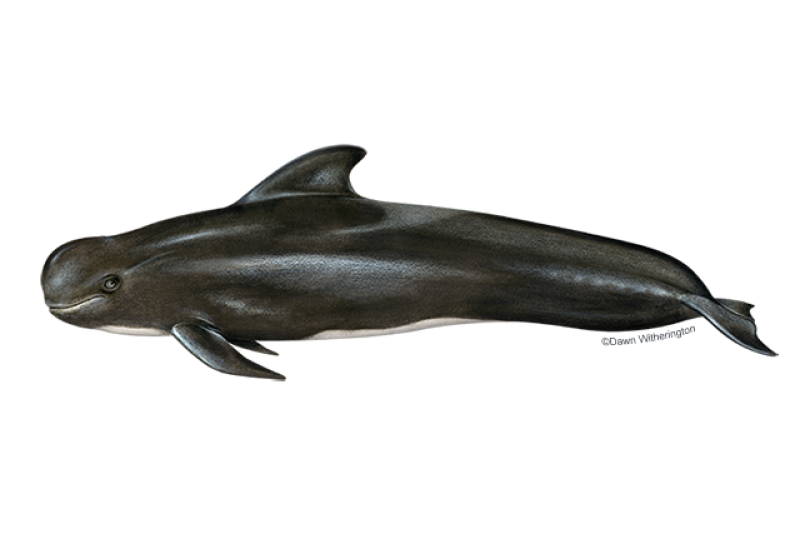Pygmy Killer Whale
Feresa attenuata
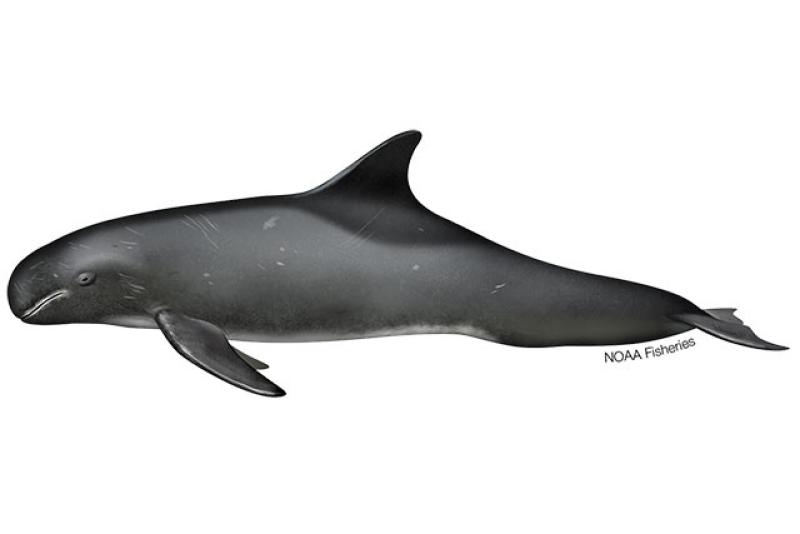
Protected Status
Quick Facts
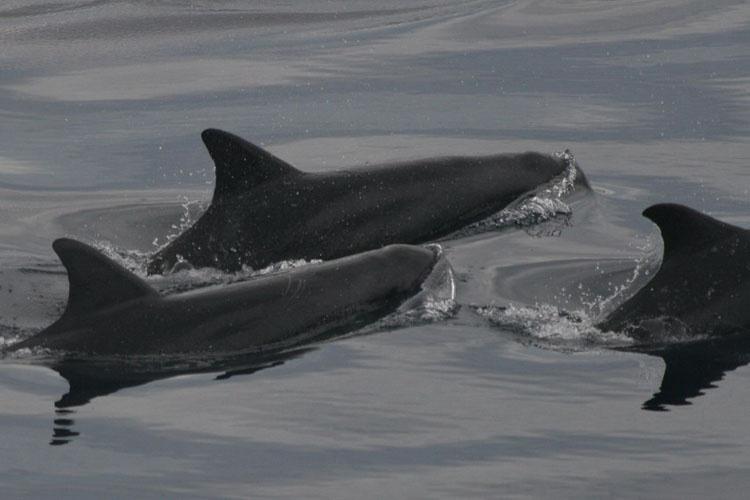 Pygmy killer whales. Credit: NOAA Fisheries
Pygmy killer whales. Credit: NOAA Fisheries
Pygmy killer whales. Credit: NOAA Fisheries
About the Species
 Pygmy killer whales. Credit: NOAA Fisheries
Pygmy killer whales. Credit: NOAA Fisheries
Pygmy killer whales. Credit: NOAA Fisheries
Despite its common name, the pygmy killer whale is a small member of the oceanic dolphin family. They are often confused with false killer whales and melon-headed whales. This species is found primarily in deep waters throughout tropical and subtropical areas of the world. Until a live animal was discovered in 1954, pygmy killer whales were known only from two fossil skulls for over a century. Not much is known about them, and they are considered naturally rare.
Although they face threats from entanglement in fishing gear, pygmy killer whales in the United States are not endangered or threatened. Like all marine mammals, they are protected under the Marine Mammal Protection Act.
Population Status
NOAA Fisheries estimates population size for each stock of pygmy killer whale in its stock assessment reports. A stock is a group of animals that occupy the same area and interbreed. There are three recognized stocks in the United States: Hawaii, northern Gulf of America (formerly Gulf of Mexico), and western North Atlantic.
Appearance
Pygmy killer whales can reach a length of 8.5 feet and weigh up to 496 pounds. They are about 2.6 feet long as newborns and reach adulthood at 6.5 feet. They have a small head with a rounded melon (or forehead) that extends in front of the mouth, and they have no discernable rostrum. Their dorsal fin is relatively large and tall and is located behind the mid-back. They have relatively long, pointed, tapering flippers (pectoral fins), and their body is dark gray to black. Their most distinctive features are some small white areas on the lips and belly. They have a fairly prominent, narrow cape that dips only slightly below the dorsal fin and a light gray ventral band.
Pygmy killer whales are easily confused with melon-headed whales because of their similar appearance. The best ways to distinguish between the two species are the pygmy killer whale’s frequent paired white tooth rakes, and the clear demarcation between the pygmy killer whale’s darker cape and lighter lateral pigmentation.
Behavior and Diet
Pygmy killer whales usually occur in groups of 12 to 50 individuals but have been seen in groups up to several hundred individuals. Both sexes may remain in their birth groups throughout their lives. They are generally less active than other oceanic dolphins and are frequently seen "logging"—resting in groups at the surface with all animals oriented the same way.
Pygmy killer whales are very aggressive when kept in captivity. They feed primarily on squids and fish.
Where They Live
Pygmy killer whales prefer deeper areas of warmer tropical and subtropical waters where their prey is concentrated. They have a circumglobal range from 40º North to 35º South. They may occasionally occur relatively close to shore around oceanic islands. In the United States, they can be found in Hawaii, the northern Gulf of America, and the western North Atlantic. In Hawaiߵi, there are resident populations off Oߵahu, Penguin Bank, and Hawaiߵi Island.
Lifespan & Reproduction
Reproductive biology is poorly known in this species. Its estimated lifespan is unknown.
Threats
Entanglement
Pygmy killer whales can become entangled or captured in commercial fishing gear, such as gillnets, though there is no reported bycatch from U.S. fisheries.
Ocean Noise
Underwater noise pollution can interrupt the normal behavior of pygmy killer whales, which rely on sound to communicate. As ocean noise increases from human sources, communication space decreases—the whales cannot hear each other, or discern other signals in their environment as they do in an undisturbed ocean.
Sound can disturb important activities, such as feeding, migrating, and socializing. Scientific research has documented that ocean noise also causes marine mammals to change the frequency or amplitude of their calls, decrease foraging behavior, become displaced from preferred habitat, or increase the level of stress hormones in their bodies. If loud enough, noise can cause temporary or permanent hearing loss.
Scientific Classification
| Kingdom | Animalia | Phylum | Chordata | Class | Mammalia | Order | Cetacea | Family | Delphinidae | Genus | Feresa | Species | attenuata |
|---|
Last updated by NOAA Fisheries on 02/26/2025
What We Do
Conservation & Management
All pygmy killer whales are protected under the Marine Mammal Protection Act. Our work protects this species by:
- Reducing interactions with commercial and recreational fishing gear
- Implementing requirements to reduce serious injuries and mortalities
- Minimizing the effects of vessel disturbance, noise, and other types of human effects
- Educating the public about the threats the species face
Science
Our research projects have helped us better understand pygmy killer whales and the challenges they face. Our work includes:
- Stock assessments
- Shipboard surveys
- Aerial surveys
- Acoustic monitoring
How You Can Help
Report Marine Life in Distress
Report a sick, injured, entangled, stranded, or dead animal to make sure professional responders and scientists know about it and can take appropriate action. Numerous organizations around the country are trained and ready to respond. Never approach or try to save an injured or entangled animal yourself—it can be dangerous to both the animal and you.
Learn who you should contact when you encounter a stranded or injured marine animal
Keep Your Distance
Be responsible when viewing marine life in the wild. Observe all small whales from a safe distance of at least 100 yards and limit your time spent observing to 30 minutes or less.
Report a Violation
Call the NOAA Fisheries Enforcement Hotline at (800) 853-1964 to report a federal marine resource violation. This hotline is available 24 hours a day, 7 days a week for anyone in the United States.
You may also contact your closest NOAA Office of Law Enforcement field office during regular business hours.
Do Not Interact with Marine Animals in the Wild
Do not harass, feed, hunt, capture, kill, pursue, approach, surround, swim with, or attempt to touch protected marine wildlife. Never entice protected marine wildlife to approach you.
Do not engage, chase, or try to get a reaction from the animal. Disturbing wildlife interrupts their ability to perform critical functions such as feeding, breeding, nursing, resting, and socializing.
If you’re on a vessel and a marine animal approaches you, put the engine in neutral and allow the animal to continue on its way.
Featured News

 Rice's Whale. Credit: NOAA Fisheries
Rice's Whale. Credit: NOAA Fisheries
Protecting Species While Planning for Offshore Wind Development in the U.S. Gulf of Mexico
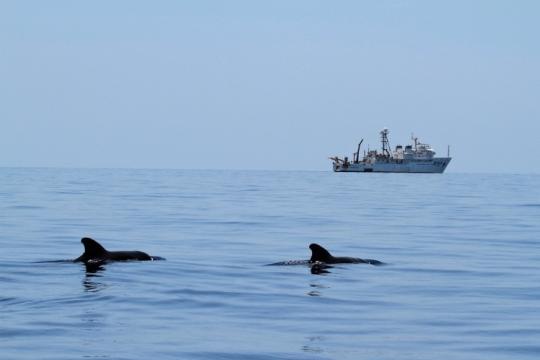 Pilot whales surface near the NOAA Ship Gordon Gunter. Credit: NOAA Fisheries/Melody Baran (Permit # 14450)
Pilot whales surface near the NOAA Ship Gordon Gunter. Credit: NOAA Fisheries/Melody Baran (Permit # 14450)
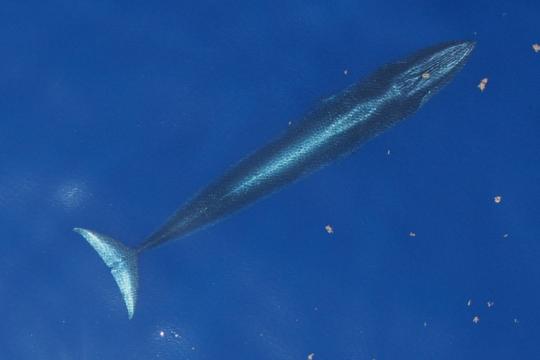 A Rice’s whale just under the surface of the water in the Gulf of Mexico. This endangered whale was recognized as a separate species from the Bryde’s whale in 2021. Credit: NOAA Fisheries under NOAA Permit No. 21938.
A Rice’s whale just under the surface of the water in the Gulf of Mexico. This endangered whale was recognized as a separate species from the Bryde’s whale in 2021. Credit: NOAA Fisheries under NOAA Permit No. 21938.
Celebrate Whale Week with Us: A Message from Janet Coit, Assistant Administrator of NOAA Fisheries
Management Overview
The pygmy killer whale is protected throughout its range under the Marine Mammal Protection Act.
Additionally, the pygmy killer whale is listed under:
- Appendix II of the Convention on International Trade in Endangered Species of Wild Fauna and Flora (CITES)
- Annex II of the Protocol for Specially Protected Areas and Wildlife (SPAW)
Conservation Efforts
Reducing Interactions with Fishing Gear
Pygmy killer whales can be entangled or caught as bycatch in fishing gear, such as gillnets. NOAA Fisheries is committed to minimizing bycatch in U.S. fisheries to ensure they remain sustainable and to protect species such as the pygmy killer whale.
Learn more about bycatch and fisheries interactions
Overseeing Marine Mammal Health and Stranding Response
We work with volunteer networks in all coastal states to respond to marine mammal strandings including all whales. When stranded animals are found alive, NOAA Fisheries and our partners assess the animal’s health and determine the best course of action. When stranded animals are found dead, our scientists work to understand and investigate the cause of death. Although the cause often remains unknown, scientists can sometimes attribute strandings to disease, harmful algal blooms, vessel strikes, fishing gear entanglements, pollution exposure, and underwater noise. Some strandings can serve as indicators of ocean health, giving insight into larger environmental issues that may also have implications for human health and welfare.
Learn more about the Marine Mammal Health and Stranding Response Program
Marine Mammal Unusual Mortality Events
Pygmy killer whales have never been part of a declared unusual mortality event. Under the Marine Mammal Protection Act, an unusual mortality event is defined as "a stranding that is unexpected; involves a significant die-off of any marine mammal population; and demands immediate response." To understand the health of marine mammal populations, scientists study unusual mortality events.
Get information on active and past UMEs
Get an overview of marine mammal UMEs
Addressing Ocean Noise
Increasing evidence suggests that exposure to intense underwater sound in some settings may cause some cetaceans to strand and ultimately die. NOAA Fisheries is investigating all aspects of acoustic communication and hearing in marine animals, as well as the effects of sound on behavior and hearing. In 2016, we issued marine mammal acoustic technical guidance for assessing the effects of anthropogenic sound on marine mammal hearing.
Regulatory History
Pygmy killer whales are protected under the MMPA.
Key Actions and Documents
More Information
Last updated by NOAA Fisheries on 02/26/2025
Science Overview
NOAA Fisheries conducts a variety of research on the biology, behavior, and ecology of pygmy killer whales. The results of this research are used to inform management decisions and enhance protection efforts for this species.
Stock Assessments
Determining the size of pygmy killer whale populations helps resource managers gauge the success of NOAA Fisheries’ conservation measures. Our scientists collect and present these data in annual stock assessment reports.
Shipboard Studies
NOAA Fisheries conducts research cruises to collect information on pygmy killer whale stocks, such as habitat preferences and feeding ecology. For example, the NOAA Pacific Islands Fisheries Science Center conducted a Hawaiian Islands Cetacean and Ecosystem Assessment Survey in 2017 and recorded sightings of pygmy killer whales and other cetaceans in the area. These studies help us estimate the abundance of these animals and can be used in management actions to protect them.
Acoustic Science
Our research also focuses on acoustics—the physics of the properties of sound. We study the basic acoustic behavior of cetaceans and fish, mapping the acoustic environment, and finding better ways to locate cetaceans using acoustic technologies. Our acoustic research also assesses the degree to which human-caused activities are changing the underwater soundscape, how these changes may potentially affect marine animals, and what measures can be taken to mitigate these potential effects.
More Information
Recent Science Blogs
Last updated by NOAA Fisheries on 02/26/2025
